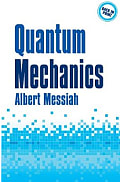内容紹介:
"Strongly recommended" by the American Journal of Physics, this volume serves as a text for advanced undergraduates and graduate students of physics as well as a reference for professionals. Clear in its presentation and scrupulous in its attention to detail, the treatment originally appeared in a two-volume French edition. This convenient single-volume translation begins with formalism and its interpretation, starting with the origins of quantum theory and examinations of matter waves and the Schrödinger equation, one-dimensional quantized systems, the uncertainty relations, and the mathematical framework and physical content of formalism.
The second half opens with an exploration of symmetries and invariance, including a consideration of angular momentum, identical particles and the Pauli exclusion principle, invariance and conservation laws, and time reversal. Methods of approximation include those involving stationary perturbations, the equation of motion, variational method, and collision theory. The final chapters review the elements of relativistic quantum mechanics, and each of the two volumes concludes with useful appendixes.
「メシアの量子力学」は物理学の中で重要な位置を占める量子力学の教科書のうち一、二を争う名著である。原書はフランス語で1959年にDunod社から初版が刊行された。2003年に出版されたフランス語版は現在はAmazon.comとAmazon.frから中古書籍だけ購入可能だ。(検索してみる)
1152ページもある英語版の新品本はしばらく売り切れ状態が続いていた。今年の2月にペーパーバック版とKindle版が発売された。分厚い本なのでKindle端末やスマートフォンのKindleアプリに入れて持ち運べるのはとても便利。しかもKindle版はペーパーバック版の半額の2千円以下で買える。
「この本はファイルサイズが大きいため、ダウンロードに時間がかかる場合があります。Kindle端末では、この本を3G接続でダウンロードすることができませんので、Wi-Fiネットワークをご利用ください。」と表示されているが、この本は固定レイアウトではない。Kindle端末、アプリ用のファイル形式なので文字の拡大/縮小をはじめKindleの機能が活用できる。
メシア「量子力学」の英語版はこちら。(ペーパーバック版とKindle版)
「Quantum Mechanics: Albert Messiah」(Kindle版)

残念なことにメシア先生は2013年4月17日に91歳でお亡くなりになりました。ご冥福をお祈りいたします。(ニュース記事)
CERNで撮影された写真

2010年撮影

参考ページ:
復刊ドットコム:メシア量子力学 1・2・3 (全3巻)
http://www.fukkan.com/fk/VoteDetail?no=8889
メシア先生の動画が見れるページ(2009年1月の映像):
フランスのレジスタンス運動やド・ゴール将軍についての思い出を話している。物理学の話をしているわけではない。(先生のお話をテキストに書き起こしたものはこのPDFファイルで読める。)
http://www.xresistance.info/article-30049282.html
第2次世界大戦中の1940年にヒトラーの隠れ家の前で撮影された写真。中央向かって右、襟巻きをしているのがメシア先生。(当時20歳。終戦時には中尉にまで昇格した。)

メシア先生の写真(2007年4月、写真右側がメシア先生):
http://www.xresistance.info/article-26077653.html
Albert Messiah (born 23 September 1921, Nice) is a French physicist.
He spent the Second World War in the French Resistance: he embarked June 22, 1940 in Saint-Jean-de-Luz to England and participated in the Battle of Dakar with Charles de Gaulle in September 1940. He joined the Free French Forces in Chad, and the 2nd Armored Division in September 1944, and participated in the assault of Hitler's Eagle's nest at Berchtesgaden in 1945.
After the war, he went to Princeton to attend the seminar of Niels Bohr on quantum mechanics. He returned to France and introduced the first general courses of quantum mechanics in France, at the University of Orsay. His textbook on quantum mechanics (Dunod 1959) has trained generations of French physicists.
He was the director of the Physics Division at the CEA and professor at the Pierre and Marie Curie University.
日本語版の中古書籍は相場価格が下がっている。
「量子力学 1:A.メシア」
「量子力学 2:A.メシア」
「量子力学 3:A.メシア」



メシア「量子力学1」:日本語版の目次情報
http://blog.goo.ne.jp/ktonegaw/e/1d53b5d3fd6577c3f5f79b7de1b51c4e
メシア「量子力学2」:日本語版の目次情報
http://blog.goo.ne.jp/ktonegaw/e/501b46a443c3de4026dda3c7c08556cb
メシア「量子力学3」:日本語版の目次情報
http://blog.goo.ne.jp/ktonegaw/e/221eb901f6ae0bf5753a94ac9f12444c
応援クリックをお願いします!





メシア「量子力学」英語版の目次:
Contents
Part 1. The formalism and its Interpretation
Chapter 1. The origins of the quantum theory
1. The end of the classical period
2. Light quanta or photons
3. Quantization of material systems
4. Correspondence principle and the old quantum theory
Chapter 2. Matter Waves and the Schr?・dinger Equation
1. Matter waves
2. The Schr?・dinger Equation
3. The time-independent Schr?・dinger equation
Chapter 3. One-Dimensional Quantized Systems
1. Square potentials
2. General properties of the one-dimensional Schr?・dinger equation
Chapter 4. Statistical Interpretation of the wave-corpuscle duality and the uncertainty relations
1. Statistical interpretation of the wave functions of wave mechanics
2. Heisenberg's uncertainty relations
3. Uncertainty relations and the measurement process
4. Description of phenomena in quantum theory. Complementarity and causality
Chapter 5. Development of the formalism of wave mechanics and its interpretation
1. Hermitean operators and physical quantities
2. Study of the discrete spectrum
3. Statistics of measurement in the general case
4. Determination of the wave function
5. Commutator algebra and its applications
Chapter 6. Classical Approximation and the WKB Method
1. The classical limit of wave mechanics
2. The WKB method
Chapter 7. General Formalism of the quantum theory: (A) Mathematical framework
1. Vectors and operators
2. Hermitean operators, projectors, and observables
3. Representation theory
Chapter 8. General Formalism: (B) Description of physical phenomena
1. Dynamical states and physical quantities
2. The equations of motion
3. Various representations of the theory
4. Quantum statistics
Part 2. Simple Systems
Chapter 9. Solution of the Schr?・dinger Equation by Separation of variables. Central potential
1. Particle in a central potential. General treatment
2. Central square-well potential. Free particle
3. Two-body problems. Separation of the center-of-mass motion
Chapter 10. Scattering problems. Central potential and phase-shift method
1. Cross sections and scattering amplitudes
2. Scattering by a central potential. Phase shifts
3. Potential of finite range
4. Scattering resonances
5. Various formulae and properties
Chapter 11. The Coulomb interaction
1. The hydrogen atom
2. Coulomb scattering
Chapter 12. The harmonic oscillator
1. Eigenstates and eigenvectors of the Hamiltonian
2. Applications and various properties
3. Isotropic harmonic oscillators in several dimensions
Appendix A. Distributions, sigma-"function" and Fourier transformation
Appendix B. Special functions and associated formulae
Contents of Volume II
Part 3. Symmetries and Invariance
Chapter 13. Angular momentum in quantum mechanics
1. Eigenvalues and eigenfunctions of angular momentum
2. Orbital angular momentum and the spherical harmonics
3. Angular momentum and rotations
4. Spin
5. Addition of angular momenta
6. Irreducible tensor operators
Chapter 14. Systems of identical particles. Pauli exclusion principle
1. Symmetrization postulate
2. Applications
Chapter 15. Invariance and conservation theorems. Time reversal
1. Mathematical complements. Antilinear operators
2. Transformations and groups of transformations
3. Invariance of the equations of motion and conservation laws
4. Time reversal and the principle of microreversibility
Part 4. Methods of Approximation
Chapter 16. Stationary Perturbations
1. Perturbation of a non-degenerate level
2. Perturbation of a degenerate level
3. Explicit forms for the perturbation expansion in all orders
Chapter 17. Approximate solutions of the time-dependent Schr?・dinger equation
1. Time dependent perturbation theory
2. Sudden or adiabatic change of the hamiltonian
Chapter 18. The variational method and associated problems
1. Variational method for bound states
2. The Hartree and Fock-Dirac atoms
3. The structure of molecules
Chapter 19. Collision theory
1. Free wave Green's function and the Born approximation
2. Generalization to distorted waves
3. Complex collisions and the Born approximation
4. Variational calculations of transition amplitudes
5. General properties of the transition matrix
Part 5. Elements of Relativistic quantum mechanics
Chapter 20. The Dirac equation
1. General Introduction
2. The Dirac and Klein-Gordon equations
3. Invariance properties of the Dirac equation
4. Interpretation of the operators and simple solutions
5. Non-relativistic limit of the Dirac equation
6. Negative energy solutions and positron theory
Chapter 21. Field quantization. Radiation theory
1. Quantization of a real scalar field
2. Coupling with an atomic system
3. Classical theory of electromagnetic radiation
4. Quantum theory of radiation
Appendix C. Vector addition coefficients and rotation matrices
Appendix D. Elements of group theory
General Index